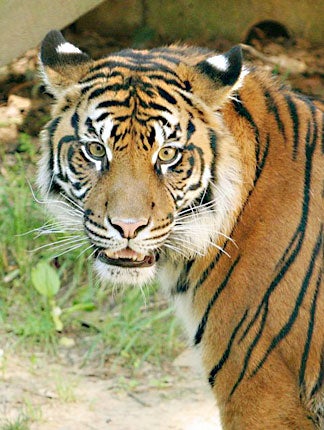Tiger, tiger, fighting back
A census that revealed a shocking drop in numbers could be the big cat's salvation as an effective rescue plan is developed in India

There are signs of hope that the world's rapidly diminishing population of wild tigers may at last be able to make a comeback. Stephen Mills, a writer and film-maker who has spent more than 20 years watching the biggest of the big cats in the wild, believes initiatives by the Indian government, and growing awareness by local people in tiger areas of the need to conserve the animals, offer new grounds for optimism in what has been a remorseless decline over the past 40 years.
There may now be as few as 4,000 tigers left in the wild from a world population estimated at 100,000 a century ago. Destruction of their forest habitat, clashes with local communities, and ceaseless hunting – not least for tiger bones to be used in traditional Asian medicine – have been the main drivers of a decline which seemed to slope towards extinction.
The steepest decline has been in India, traditionally thought of as the heartland of the tiger's range, where until recently it was estimated there were nearly 4,000 animals. But results of a thorough scientific census published late last year gave a figure of 1,411 tigers remaining across the sub-continent , which shocked conservationists in India and across the world.
It was seen as a damning indictment of the failure of Project Tiger, the nationwide conservation effort set up by India in 1973, but which did not succeed in preserving the animals it was designed to save; in recent years, tiger reserves, such as Sariska in Rajasthan, were found to contain no tigers: they had all been poached.
Yet, perversely, it is precisely this census which Mr Mills, a former head of campaigns for the Environmental Investigation Agency, believes can offer the basis for a new beginning in Indian tiger conservation. "We should not see the census results as a measure of decline, but rather as an accurate count for the first time," he said. "When they were published, it was the first time since the launch of Project Tiger 35 years earlier that we had a count of tigers done on a scientific basis, and results which would be stuck to by government scientists and conservationists, and could form the basis of action."
Mr Mills, who scripted the 1993 BBC film Tiger Crisis which revealed for the first time the extent of the trade in tiger bones and other body parts which was helping drive the decline, sets out a lengthy argument for hope for the survival of Panthera tigris in the current issue of BBC Wildlife magazine, giving five reasons for optimism. The first he says, is the 2007 census itself and the follow-up action from the Indian government, including setting up a new National Tiger Conservation Authority with a $140m (£95m), five-year plan for conservation measures, a Wildlife Crime Bureau and an armed Tiger Protection Force to combat poachers. The census itself provides the way forward.
"For the first time, government scientists and conservationists are in agreement," he writes. And efforts are being made to restore the ravages of the poachers: young tigers have been airlifted into the Sariska reserve to establish a new population. Second, Mr Mills points to efforts to identify new tiger habitat, led by the wild cat protection organisation, Panthera, headed by the celebrated American biologist Alan Rabinowitz. Dr Rabinowitz has identified vast tracts of tiger forest habitat in Burma, Thailand and Laos where there is potential for a significant increase in tiger numbers if they are protected. "He believes although only 5 per cent of the tiger's original habitat remains worldwide, it is enough to support a total population of 15,000 to 20,000 tigers," Mr Mills writes.
Third, he notes that efforts to engage local communities with tiger conservation are beginning to bear fruit. For example, in Nepal, there are now more than 1,500 Community User Forest Groups working to manage their own forests sustainably through understanding their value, including understanding the value of all wildlife. Fourth, Mr Mills takes hope from the stability of the world's largest single tiger-breeding population, the 500 Siberian tigers of the Russian Far East. He thinks these may be able to repopulate previous tiger habitat, including areas across the border in China.
Last, he notes there is reduction in the demand for tiger body parts, in particular skins used as ceremonial robes in Tibet, an extensive market revealed only in 2005, but which the Tibetan spiritual leader, the Dalai Lama, has since publicly condemned.
Mr Mills writes: "So can I really imagine 20,000 tigers living wild once more in Asia? I think I can." It would be unfair to expect too much of rural people in the most crowded habitats, he says. "We must support them and respect their needs." And India's leading experts do not believe that, in the long run, the country's tigers can survive outside strictly protected reserves. But it might be possible elsewhere, as much more is known now about tigers themselves and how to conserve them, and the animal is highly adaptable.
Mr Mills said: "I've written doom-laden articles and campaigns about tigers but now I feel the message has got through. You can't say 'tiger' to anybody without them understanding they're a diminishing and valuable resource. With many governments understanding this, perhaps we can protect the tiger and perhaps it can survive."
Join our commenting forum
Join thought-provoking conversations, follow other Independent readers and see their replies
Comments